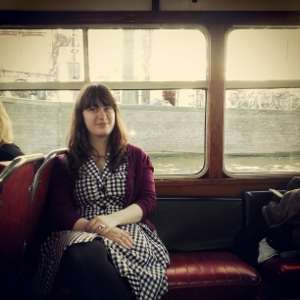Ingolf Dahl’s Concerto à tre is a three-movement piece (but played without breaks) for clarinet, cello and violin. Although it was a very fluid piece, there were many different elements within the music. The violin often played a classical-sounding melody, whereas the rhythm, drive and repetition of the piece at times reminded me of the American minimalists. The second movement conjured up images of a vast, desolate Nordic landscape while still being very comforting listening. The third movement I considered the most exciting: at times it sounded like a happy but rather mad chase.
Béla Bartók’s Contrasts for violin, clarinet and piano is an exhilarating piece of music. It is the only work of chamber music by Bartók to contain a wind instrument, but his writing for the clarinet is as powerful as for the violin and piano. At times the music was almost cacophonic – but the essential word here is almost. I found myself wondering why the music worked so well, because all the instruments were playing parts and melodies vastly different from one another, but it sounded absolutely fantastic together. Some of the clarinet parts reminded me of Bartók’s famous ballet The Miraculous Mandarin in its Stravinskian rhythm and melodies – and these were played perfectly by clarinetist Hein Wiedijk. The structure of Contrasts was similar to Dahl’s Concerto à tre - it again consists of three movements, of which the second one is the slower and darker one. But even the second movement had a fairytale-like quality, albeit a somewhat creepy fairytale. The third movement required violinist Marijn Mijnders to use two violins – one that is tuned rather differently to what we are used to. This violin opened the movement and gave the impression of folk musicians, which suited the folk influences in Bartók’s music perfectly. The third movement, like Dahl’s Concerto à tre also gave off the impression of a mad chase, or at the very least a manic dance – it is such a fast and energetic piece. Despite the technical challenge of Contrasts the three musicians were able to make sure it didn’t sound too perfect or clean but gave it that little edge Bartók’s music always needs.
The Tempest was Thomas Adès’s second opera, first premièred in 2004. In 2005 Adès wrote the Court Studies from The Tempest for violin, piano, cello and clarinet. I know The Tempest quite well and really love it, so I was rather surprised by the Court Studies. It took a while to get used to the harmonics in the piece and even made me wonder for a moment whether the instruments were tuned properly! But once I got used to the particular sound I began to appreciate the piece and realized what a beautiful adaptation of the opera it really is. There is a certain modesty and simplicity to it, with especially beautiful slow sections. The clarinet brought a clarity of tone in the piece, sometimes reminding me of the role of Ariel in The Tempest. The ending was nothing short of heartbreaking – beautiful harmonies fading away. Like many Adès pieces, it takes a while to get into Court Studies but if you persist it will be more than paid off.
Dvořák’s Piano Trio no. 4 was the most famous work played this evening and also the most traditional-sounding. It consists of 6 movements and what struck me the most was how incredibly beautiful the parts for the cello were. Although the violin often played the melodies, it was the cello that stole the show, and cellist Jérôme Fruchart played incredibly well, leaving the audience breathless. It is quite an upbeat and fast piece, but has a certain broodiness to it that Dvořák always does so well. The second movement was particularly memorable to me – starting off quite sad, with the cello dictating the mood, but then the piano comes in and offers hope, after which it turns into a dance. Despite its more traditional sound, the Dvořák piece definitely fit in with the rest of music played tonight – all had a bit of an edge but lots of energy and fascinating harmonies.
It is always fun to see orchestra members play chamber music. When you watch an orchestra they tend to operate as one. These chamber music pieces required exceptional skill from every single musician and not only required them to work together well but also to stand out. This they did incredibly well, with Fruchart playing especially stunningly, and I can’t fault any of the musicians. As the last concert of the year for me it was certainly a beautiful ending and I hope for more of these evenings next year.


